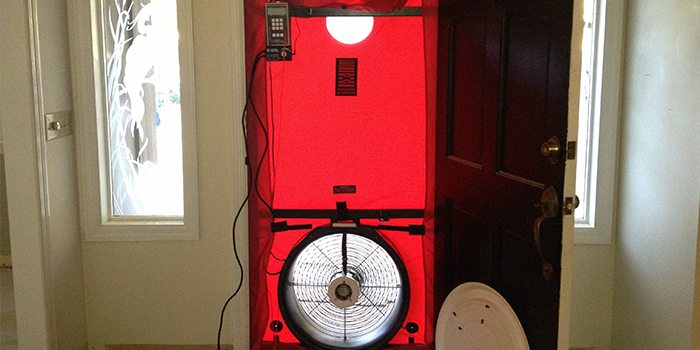
Blower Door Tests

Back to Education Center | Architect's Guide | Building Envelopes and SPF
Blower Door Tests
Many homeowners have decided that building their homes tight is the way to build them right, as eliminating air leakage through cracks, gaps, and holes in a typical house can save 25%-40% on energy consumption and utility bills, per Energy Star. In providing assurance that a home is in fact airtight, builders use a valuable process called a blower door test.
What is a Blower Door Test?
Blower door tests are fairly simple: they’re used extensively to measure the airtightness of a home or building and determine where any leaks are located. Blower door tests enable the builder to eliminate guesswork regarding leakage and airtightness. The test methodology is widely accepted as one of the main predictors for energy efficiency in homes. The safety of ventilation levels for occupants can also be assessed. Energy retrofitters have used blower door tests for years to measure the success of their air sealing efforts.
Builders who carry out repeated blower door testing on finished houses learn to anticipate where and how air leakage problems are likely to occur, and are able to find ways of avoiding them during the construction process. By avoiding air leakage problems in the first place, builders can avoid costly callbacks and increase customer satisfaction. In addition, the knowledge that builders gain from the frequent use of this testing leads to a better understanding of the dynamics of airflow in buildings, and thus a better understanding of how their buildings actually perform.
The Blower Door System and Testing Process
A blower door test kit consists of a powerful, variable-speed fan with a speed controller mounted in an adjustable panel that is temporarily fit into an open exterior doorway (see image above). Pressure gages measure pressure differences generated by the fan and airspeed gauges measure airflow across a calibrated opening in the fan.
Test procedures are fairly straightforward, and blower door test kits usually include detailed instructions provided by the supplier or manufacturer. After the necessary procedures to set up the house have been performed, the test itself takes about 10 to 15 minutes to conduct.
Essentially, a blower door test depressurizes a home by blowing indoor air outside. The pressure difference between the inside and outside is converted to airflow in CFM (cubic feet per minute). The airflow measurement can be used to determine the air change rate, measured in ACH or air changes per hour, which is the time it takes for the entire volume of air in a home to be replaced. (The lower the number, the tighter the home: energy efficient homes should definitely be under 1.5ACH, and ideally under 1.0). During testing, air leaks can be located via smoke wands and subsequently sealed.
Blower door tests should be conducted in accordance with ASTM E1827 Standard Test Methods for Determining Airtightness of Buildings Using an Orifice Blower Door.






